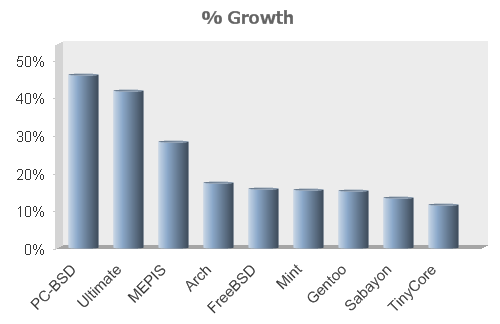PC-BSD and FreeBSD are Two of the Fastest Growing Open Source Operating Systems Last Year while Ubuntu-based Operatings system lead growth
So PC-BSD and FreeBSD are getting a lot more attention. They are growing fast. Reports created based on the data from DistroWatch show that PC-BSD and FreeBSD are two of the fastest growing operating systems last year. Of course, despite my bias towards FreeBSD, as it is my favorite distribution, the numbers clearly show that Ubuntu/Debian-based platforms lead the growth.
Ok, so DistroWatch.com counts the hits per day (HPD) to a distro’s home page. Lets compare the hits per day over the past twelve months to the hits per day over the past 6, 3, 1 month intervals to see who is experience the most growth in hits per day as well as who has the highest percentage growth.
Growth in hits per day (HPD) between the 12 month and 1 month charts
Is one month a valid sample size? Of course not, that is why we are doing three month and six months as well. But lets look at it anyway.
PC-OS appears to have the lead here. PC-OS is based on Ubuntu (which itself is Debian-based). Other Ubuntu/Debian-based platforms showing growth are Debian itself, MEPIS, Mint, and Ultimate.
The only other base platform to have more than one distro show up in this list is FreeBSD. As you can see, PC-BSD is second in growth on both HPD and percentage, and FreeBSD is fifth in HPD growth and third in percent growth.
Growth in hits per day (HPD) between the 12 month and 3 month charts
Three months is definitely a larger sample size. Three months means we don’t have as much data skewed by release cycles which cause higher growth temporarily that will be offset by a decline the long months between release cycles.
Again we see similar trends in the three month reports.
Debian itself , MEPIS, Mint, and Ultimate and are all Debian/Ubuntu-based distros.
Again, FreeBSD and PC-BSD are on both the list. PC-BSD is second in HPD growth and leads all distributions in percentage growth.
Growth in hits per day (HPD) between the 12 month and 6 month charts
Ok, so the twelve to six month comparison is the largest sample size can get. Perhaps I should contact DistroWatch.com and see if I can get the raw data for multiple years past, but alas, I only pull the data from the tables they have currently available.
So now we see very similar data again. Seeing similar data a third time using this largest sample size means it is more likely accurate.
Fedora ties Ultimate for first, but the tie breaker has to go to Ubuntu/Debian-based plaftorms as they again lead Mint, Ubuntu, and Ultimate all on the list.
FreeBSD is on both HPD and percentage reports, while PC-BSD only shows up on the percentage report. However, again, FreeBSD is the only base open source operating system after Ubuntu/Debian-based to have two distributions show up between these two lists. For those interested, PC-BSD was fifteenth but only the top eight distros are displayed.
Note: For information on how these reports are created, see this post:
Using QlikView and DistroWatch to report on the most popular open source distributions (BSD, Linux, Unix)
Copyright ® Rhyous.com – Linking to this article is allowed without permission and as many as ten lines of this article can be used along with this link. Any other use of this article is allowed only by permission of Rhyous.com.







